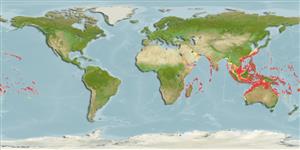Actinopterygii (ray-finned fishes) >
Perciformes (Perch-likes) >
Scombridae (Mackerels, tunas, bonitos) > Scombrinae
Etymology: Gymnosarda: Greek, gymnos = naked + Greek, sarde = sardine; 1598 (Ref. 45335).
Environment / Climate / Range
Ecology
Marine; reef-associated; oceanodromous (Ref. 51243); depth range 10 - 250 m (Ref. 86942). Tropical; 20°C - 28°C (Ref. 5313), preferred 28°C (Ref. 107945); 31°N - 30°S, 32°E - 130°W (Ref. 168)
Indo-Pacific: Red Sea and East Africa to French Polynesia, north to Japan, south to Australia.
Size / Weight / Age
Maturity: Lm ? range ? - ? cm
Max length : 248 cm FL male/unsexed; (Ref. 40637); common length : 190 cm NG male/unsexed; (Ref. 9710); max. published weight: 131.0 kg (Ref. 168)
Dorsal
spines
(total): 13 - 15;
Dorsal
soft rays
(total): 12-14;
Anal
spines: 0;
Anal
soft rays: 12 - 13;
Vertebrae: 38. Mouth fairly large, upper jaw reaching to middle of eye. Laminae of olfactory rosette 48 to 56. Interpelvic process large and single. Lateral line strongly undulating. Body naked posterior to corselet. Swim bladder large, spleen visible in ventral view on the right side of the body. The back and upper sides brilliant blue-black, lower sides and belly silvery; no lines, spots or other markings on the body.
An offshore species found mainly around coral reefs. Generally solitary or occur in small schools of six or less. Preys on small schooling fishes such as Decapterus, Caesio, Nasio, Cirrhilabrus, Pterocaesio and squids. Marketed canned and frozen (Ref. 9684, 48637). Adults may be ciguatoxic (Ref. 37816).
Life cycle and mating behavior
Maturity | Reproduction | Spawning | Eggs | Fecundity | Larvae
Collette, B.B. and C.E. Nauen, 1983. FAO Species Catalogue. Vol. 2. Scombrids of the world. An annotated and illustrated catalogue of tunas, mackerels, bonitos and related species known to date. Rome: FAO. FAO Fish. Synop. 125(2):137 p. (Ref. 168)
IUCN Red List Status (Ref. 115185)
CITES (Ref. 94142)
Not Evaluated
Threat to humans
Reports of ciguatera poisoning (Ref. 168)
Human uses
Fisheries: minor commercial; gamefish: yes
More information
ReferencesAquacultureAquaculture profileStrainsGeneticsAllele frequenciesHeritabilityDiseasesProcessingMass conversion
Tools
Special reports
Download XML
Internet sources
Estimates of some properties based on models
Phylogenetic diversity index (Ref.
82805): PD
50 = 1.0000 [Uniqueness, from 0.5 = low to 2.0 = high].
Bayesian length-weight: a=0.01000 (0.00541 - 0.01847), b=3.05 (2.90 - 3.20), in cm Total Length, based on LWR estimates for this species & (Sub)family-body (Ref.
93245).
Trophic Level (Ref.
69278): 4.5 ±0.75 se; Based on food items.
Resilience (Ref.
69278): Low, minimum population doubling time 4.5 - 14 years (Assuming tmax>10).
Vulnerability (Ref.
59153): High to very high vulnerability (73 of 100) .
